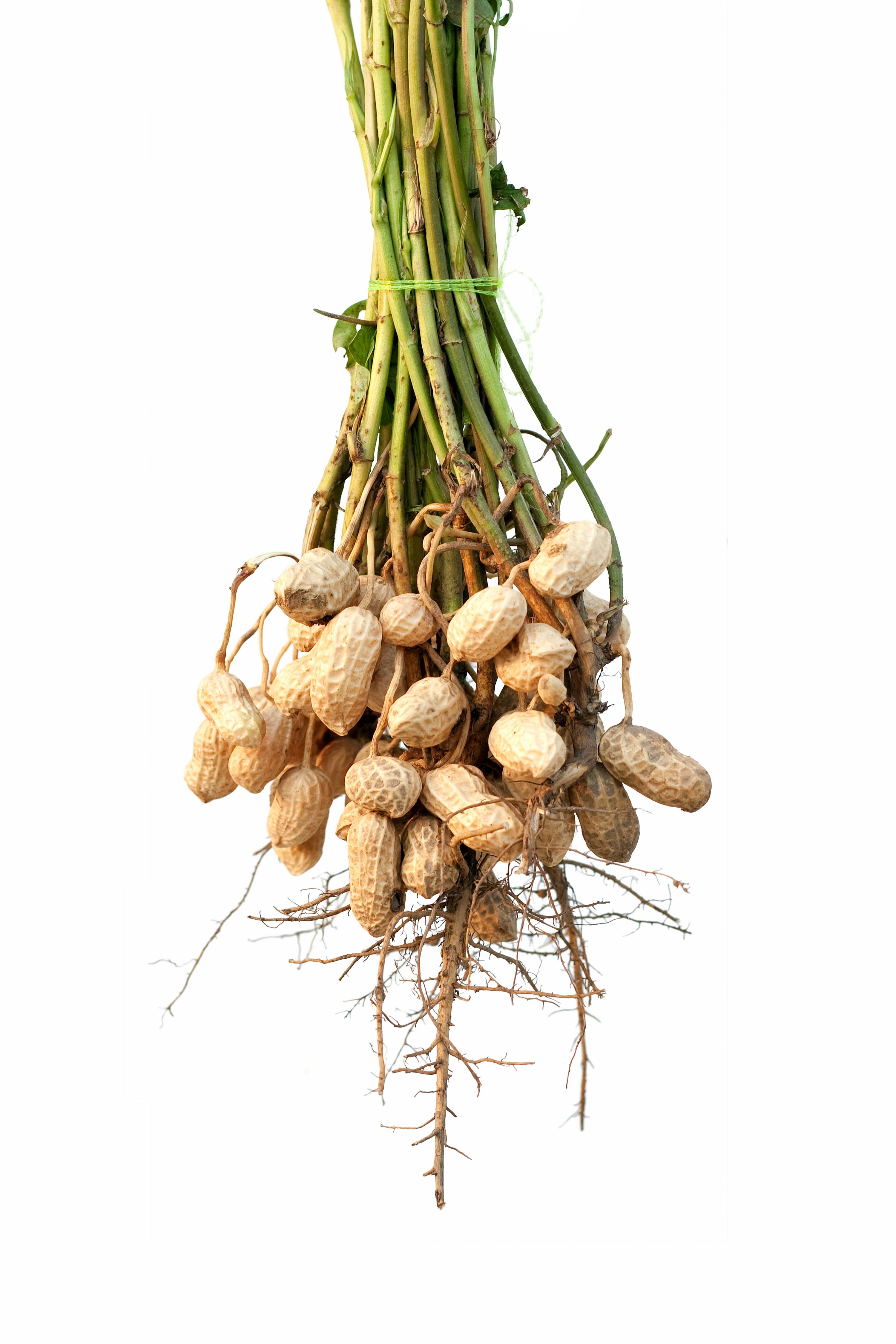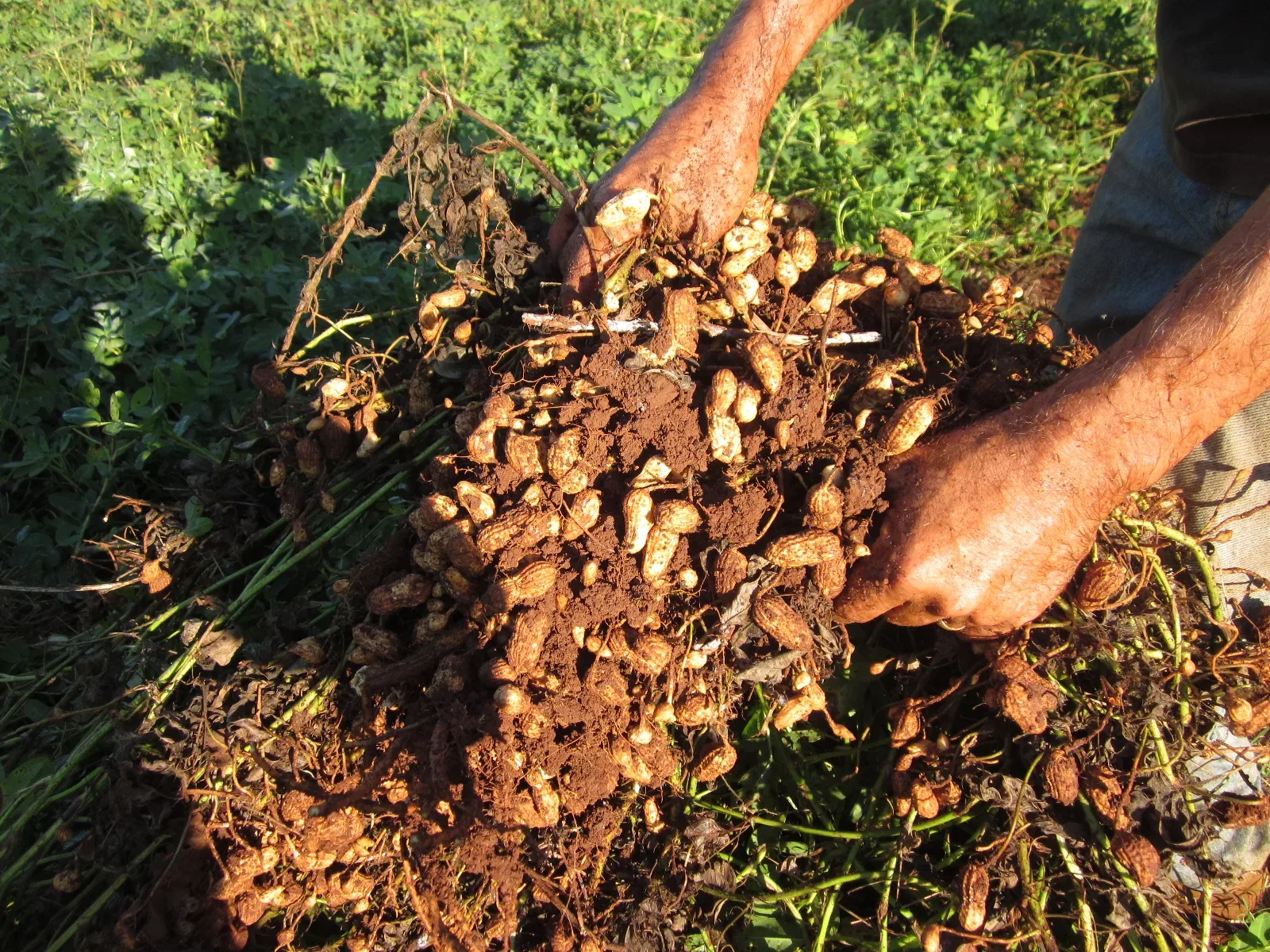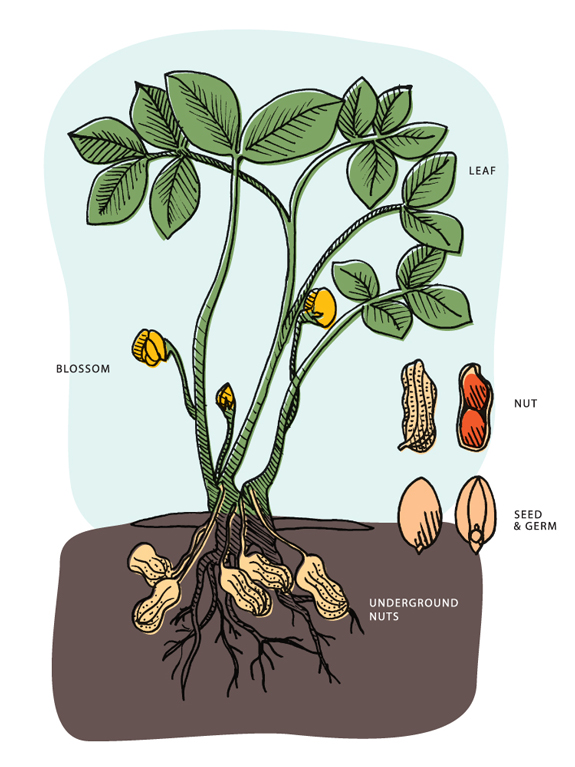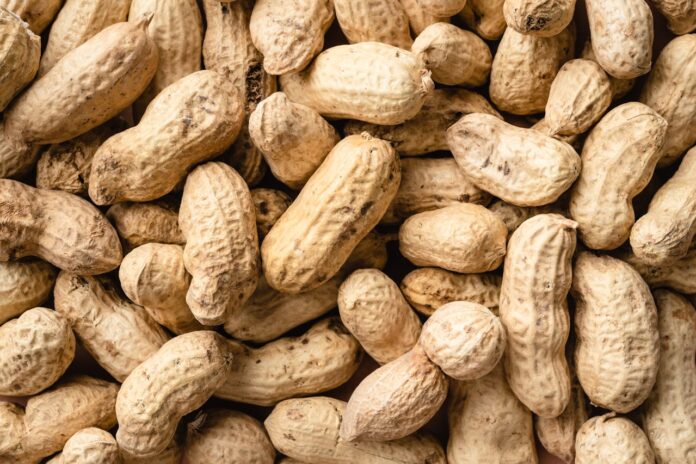Peanuts grow underground, starting as a flower that bends towards the ground to bury itself. Peanuts, scientifically known as Arachis hypogaea, are unique legumes that grow underground.
Belonging to the pea family, peanuts begin their growth cycle by producing yellow, pea-like flowers. Once pollinated, the flower elongates a stalk that bends towards the ground, eventually burying itself in the soil. This process results in the formation of a peanut pod below the ground.
Inside the pod, the peanuts develop and mature, ready for harvesting. Understanding the growth process of peanuts is essential for farmers to ensure optimal conditions for a successful harvest. Let’s delve deeper into the fascinating journey of how peanuts grow and the factors influencing their development.
The Botanical Background Of Peanuts
Peanuts, scientifically known as Arachis hypogaea, are fascinating plants that belong to the legume family. Despite the name, peanuts are not actually nuts; they are classified as legumes due to their unique growth and development characteristics. Understanding the botanical background of peanuts can provide insights into how these versatile plants grow and differentiate themselves from true tree nuts.
Peanut Plant Characteristics
Peanut plants are small, annual plants that typically reach a height of 1-2 feet. They have a shallow root system and produce yellow flowers that develop into pods. The flowers are self-pollinating, meaning they can fertilize themselves without the need for external assistance. This adaptability allows peanuts to thrive in a variety of climates, including warm and tropical regions.
The most distinctive feature of the peanut plant is its process of fruit development. After successful pollination, the flower stalk elongates and bends downwards, eventually burying itself into the ground. This unique behavior is called geocarpy and is responsible for the peanut’s unusual growth pattern.
Peanut Vs. Tree Nuts: A Clarification
While peanuts are often grouped together with tree nuts due to their similar taste and usage, they have distinct differences in botanical classification. Unlike tree nuts, which grow on trees and have hard shells, peanuts grow underground and have a soft, edible shell. This differentiation is crucial for individuals with allergies, as peanut allergies are more common and can have more severe reactions compared to tree nut allergies.
Furthermore, peanuts and tree nuts have different nutritional profiles. Peanuts are rich in protein, healthy fats, and various vitamins and minerals, while tree nuts offer their own unique set of nutrients. Understanding these differences can help individuals make informed dietary choices and cater to specific nutritional needs.
In conclusion, the botanical background of peanuts sheds light on their growth habits and differentiation from true tree nuts. By recognizing the distinctive characteristics of peanut plants and understanding their place within the legume family, we can appreciate the unique nature of these versatile legumes.
From Seed To Seedling
Peanuts grow from seeds to seedlings through a fascinating process. The seeds are planted in warm soil, where they sprout and develop into young plants. With proper care and nurturing, these seedlings grow into mature peanut plants that bear the delicious legumes we enjoy.
Peanuts are a favorite snack for many, but have you ever wondered how they grow? From seed to seedling, the process is fascinating and involves several stages. In this post, we will explore the early stages of peanut growth, including the germination process and the early growth stages.
Germination Process
The germination process is the first stage in the growth of peanuts. It starts with the planting of the peanut seed, which is usually done in the spring. The seed needs moisture, warmth, and oxygen to begin the germination process. As the seed absorbs water, it softens and begins to swell. This causes the seed coat to split, and a small root emerges. The root then grows down into the soil, while the shoot grows upward.
Early Growth Stages
How Do Peanuts Grow? Once the peanut seed has germinated, the early growth stages begin. At this stage, the plant requires plenty of water and sunlight to grow. The plant will continue to grow and develop leaves, stems, and roots. The leaves are important for the plant’s growth as they absorb sunlight and carbon dioxide, which are essential for photosynthesis. The stem provides support for the plant, while the roots absorb water and nutrients from the soil. During this stage, the peanut plant will also start to flower. The flowers are small and yellow and will eventually turn into pegs.
The pegs are the structures that will develop into peanuts. As the pegs grow, they begin to elongate and move downward towards the soil. When the pegs reach the soil, they will penetrate it and start to develop into peanuts. In conclusion, the growth of peanuts is a fascinating process that involves several stages. From the germination process to the early growth stages, the plant requires plenty of water, sunlight, and nutrients to grow. Understanding how peanuts grow can help us appreciate the effort that goes into producing this tasty snack.
The Life Cycle Of A Peanut Plant
Understanding the life cycle of a peanut plant is fascinating and provides insights into how these delicious nuts are formed. From the vegetative stage to the reproductive phase, each step in the growth process plays a crucial role in the development of peanuts.
Vegetative Stage
The vegetative stage is the initial phase in the life cycle of a peanut plant. It begins with the germination of the peanut seed, where it absorbs moisture and swells. This leads to the emergence of the primary root, followed by the growth of the hypocotyl, which pushes the cotyledons above the soil surface.
During this stage, the peanut plant focuses on establishing a strong root system and developing its leaves. The roots absorb nutrients and water from the soil, while the leaves capture sunlight to fuel photosynthesis. Photosynthesis is a vital process where the plant converts carbon dioxide and sunlight into energy, allowing it to grow and thrive.
Reproductive Phase
Once the peanut plant has reached maturity, it enters the reproductive phase. This phase is characterized by the formation of flowers, which eventually give rise to the familiar peanut pods. The flowers of a peanut plant are self-pollinating, meaning they do not rely on external agents like bees or wind for pollination.
After pollination, the flowers develop into pegs, elongated structures that penetrate the soil. The pegs then undergo geotropism, a response to gravity that causes them to curve downward and burrow into the ground. Once underground, the pegs continue to grow, forming the peanut pods.
Inside the pods, the fertilized ovules develop into peanuts. As the pods mature, they harden and turn yellow, indicating that the peanuts are ready for harvest. The plant allocates nutrients to the growing peanuts, ensuring they develop into the delicious nuts we enjoy.
Throughout its life cycle, a peanut plant requires adequate sunlight, water, and nutrients to thrive. Farmers carefully cultivate these plants, providing optimal conditions for growth and ensuring a bountiful harvest.
The Unique Reproductive Strategy
Peanuts grow in a fascinating way, with their flowers developing above ground before bending down to burrow into the soil to mature. This unique reproductive strategy allows the peanut plant to produce its pods underground, ensuring protection and successful seed development.
Pollination
Peanuts, with their unique reproductive strategy, rely on pollination to produce the tasty legumes we enjoy. Unlike most plants, peanuts are self-pollinating, meaning they have the ability to pollinate themselves without the help of external factors such as insects or wind. This self-pollination is facilitated by the flowers’ structure, which forms a closed structure known as a keel. The keel protects the reproductive organs and allows for efficient self-pollination.
Pegging
Once pollination occurs, a fascinating process called pegging takes place. The peanut plant’s flowers have the ability to elongate their ovaries, forming a structure known as a peg. This peg then penetrates the soil, where it will eventually develop into a peanut pod. This unique feature of peanut plants allows them to grow their fruits underground, creating a rather unconventional growing process.
The Journey Underground
After the peg has entered the soil, the fertilized ovary at the tip begins to develop into a peanut pod. The pod then undergoes a maturation process, gradually growing larger and filling with the familiar peanut kernels. While underground, the peanut pod receives nutrients and water from the plant’s roots. This process typically takes around 100 to 120 days, depending on the variety of peanut and the environmental conditions.
In summary, peanuts have a fascinating reproductive strategy that involves self-pollination and pegging. This unique process allows the flowers to pollinate themselves and for the fruits to develop underground. Understanding the journey of peanuts from pollination to underground growth gives us a deeper appreciation for these delicious legumes.
Cultivating Peanuts: Agricultural Practices
When it comes to cultivating peanuts, it’s crucial to understand the agricultural practices that contribute to their successful growth. From soil requirements to climate conditions, each element plays a pivotal role in the cultivation of this popular legume.
Soil Requirements
Peanuts thrive in well-drained, loose, and sandy soil that allows for easy penetration of the developing pods. The ideal soil pH for peanut cultivation ranges between 5.8 and 6.2, providing the necessary acidic conditions for optimal growth. Adequate levels of calcium and potassium are essential for promoting healthy root development and pod formation.
Climate Conditions
Optimal peanut cultivation occurs in warm, sunny climates with a growing season of approximately 4 to 5 months. Consistent temperatures ranging from 70°F to 90°F (21°C to 32°C) are ideal for supporting the various growth stages of peanuts, from flowering to pod development. Additionally, adequate moisture, preferably through well-distributed rainfall or controlled irrigation, is crucial to ensure proper hydration for peanut plants.

Credit: www.countryliving.com
Challenges In Peanut Farming
In peanut farming, there are various challenges that farmers encounter, ranging from pests and diseases to water management. These challenges require careful attention and strategic approaches to ensure a successful peanut crop. Let’s delve into the specific challenges faced in peanut farming.
Pests And Diseases
Peanut crops are susceptible to a range of pests and diseases, including thrips, aphids, white mold, and leaf spot. These can significantly impact the yield and quality of the peanuts. Farmers often employ integrated pest management techniques, such as crop rotation, pest-resistant varieties, and targeted pesticide application, to mitigate the impact of these threats.
Water Management
Effective water management is crucial in peanut farming, as these crops require consistent moisture levels for optimal growth. Over-irrigation can lead to waterlogging and fungal diseases, while under-irrigation can result in stunted growth and reduced yields. Farmers utilize irrigation systems like drip irrigation and pivot sprinklers to ensure precise and efficient water delivery to the peanut fields.
Harvesting And Post-harvest Processing
When peanuts are ready for harvest, the process of Harvesting and Post-Harvest Processing begins. Let’s take a closer look at how peanuts are harvested and processed.
Digging And Drying
- Peanuts are dug out of the ground using special equipment.
- They are then left to dry in the sun to reduce moisture content.
Shelling And Grading
- The dried peanuts are shelled to remove the outer shell.
- After shelling, the peanuts are graded based on size and quality.

Credit: www.thetreecenter.com
Peanuts On The Market: Consumption And Uses
Peanuts grow underground as the seeds of the peanut plant, which thrives in warm climates. The plant produces yellow flowers that eventually develop into peanut pods. As the pods mature, they bend down to the ground and bury themselves, where the peanuts continue to grow.
Food Products
Peanuts are consumed in various forms, including peanut butter and roasted peanuts.
Industrial Applications
Peanut oil is used in cooking and cosmetics due to its health benefits. Peanuts are versatile and widely used across different industries.

Credit: www.flpeanuts.com
Frequently Asked Questions
How Do Peanuts Grow?
Peanuts grow underground, not on trees. The peanut plant flowers above ground but the peanut pods develop below the soil. The plant requires sandy, well-drained soil and plenty of warm weather to thrive.
What Is The Growing Season For Peanuts?
Peanuts are typically planted in the spring and harvested in the fall. The growing season for peanuts varies depending on the climate and location, but it generally lasts for about 5 to 6 months.
Are Peanuts A Type Of Nut?
Despite their name, peanuts are not true nuts. They belong to the legume family and are related to beans, lentils, and soy. They grow in pods underground, unlike tree nuts which grow on trees.
Conclusion
Peanuts are a fascinating crop that have been cultivated for thousands of years. They are a unique plant that grows underground and require a specific set of conditions to grow successfully. By understanding the peanut plant’s life cycle and the factors that influence its growth, farmers can optimize their yields and produce high-quality peanuts.
With the right care and attention, anyone can grow peanuts and enjoy their delicious taste and nutritional benefits. So, whether you’re a farmer, gardener, or peanut enthusiast, learning how peanuts grow is a rewarding experience that’s sure to pay off in the long run.


